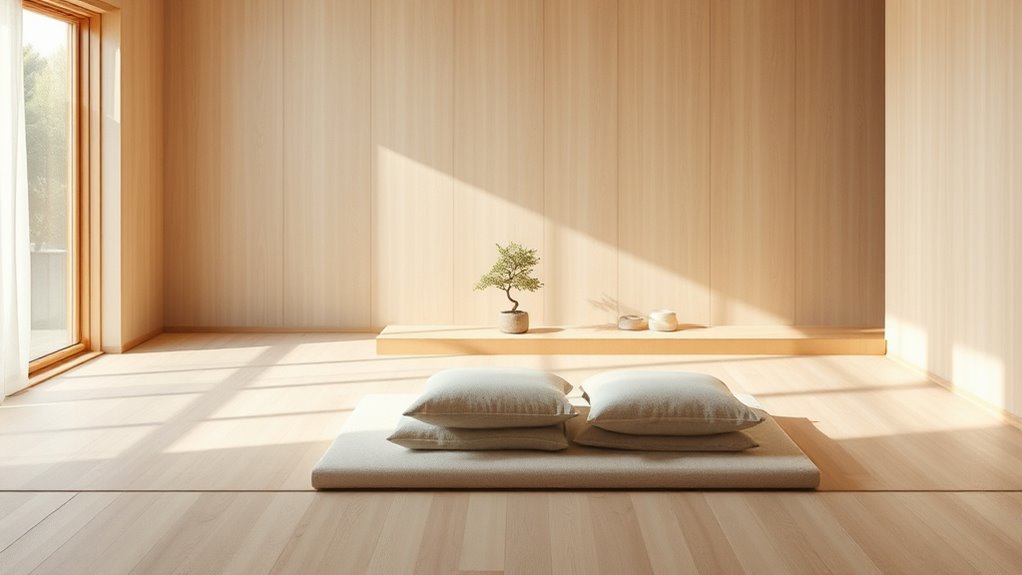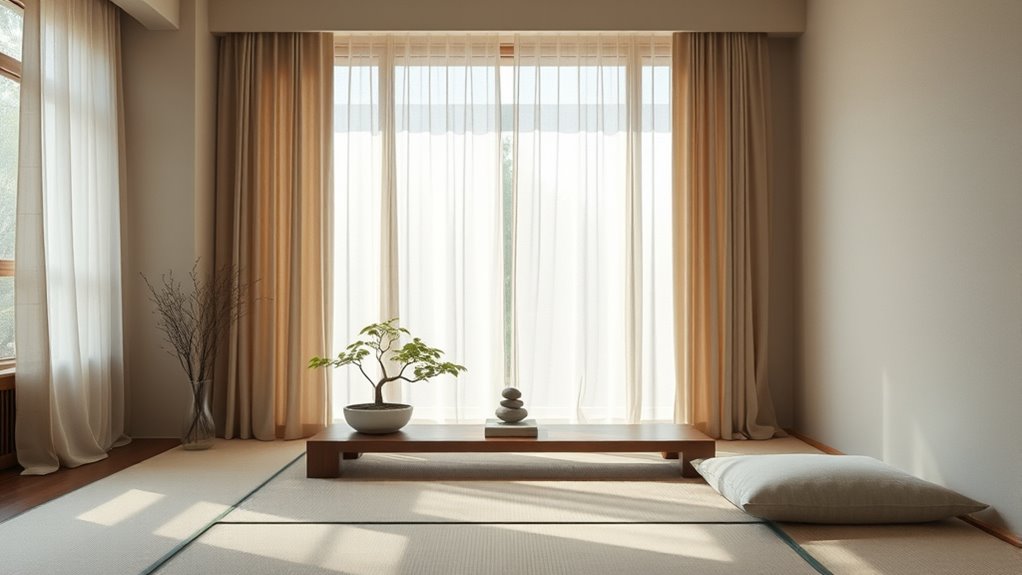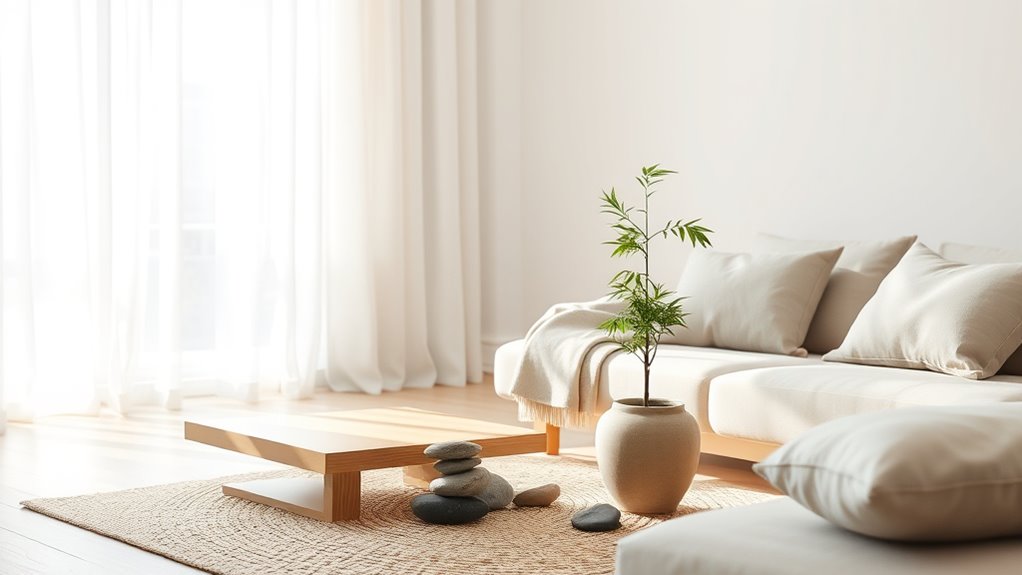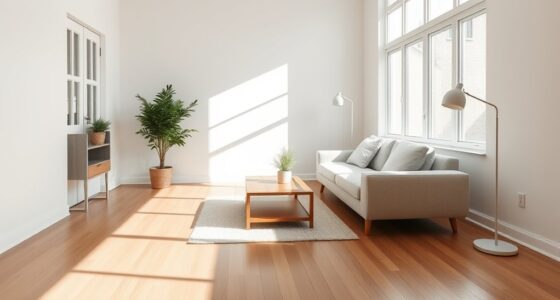To lower your stress with Zen décor, embrace simplicity by decluttering and choosing minimal, functional pieces that promote calm. Focus on balance and harmony through symmetry and natural elements like plants or water features. Incorporate soothing textures and soft lighting to engage your senses comfortably. Design quiet spaces for reflection and connect with nature using earth tones and natural materials. Keep exploring, and you’ll discover more ways to create a serene, stress-reducing environment.
Key Takeaways
- Embrace minimalism by reducing clutter and using simple, functional decor to create a calm, organized space.
- Incorporate natural elements like plants, water features, and natural textures to foster serenity and connection with nature.
- Use neutral color palettes and soft lighting to promote a soothing, tranquil environment that lowers stress.
- Design for balance and harmony with symmetry and focused decor to enhance mental clarity and emotional stability.
- Prioritize natural light and sustainable materials to create an organic, peaceful atmosphere that supports relaxation.
Embracing Simplicity Through Minimalism

Embracing simplicity through minimalism invites you to create a space free of clutter, which can substantially lower your stress levels. With a clutter-free environment, you foster a calm and focused atmosphere that supports mental clarity. Minimalist decor emphasizes clean lines, neutral color palettes, and functional furniture that promote serenity. By reducing visual distractions, you enhance your ability to relax and concentrate. Prioritizing quality over quantity means choosing purposeful items that serve a real function or hold meaningful value. This approach minimizes sensory overload, making your space more peaceful and centered. Incorporating quality materials into your decor can further elevate the sense of calm and durability within your environment. A minimalist design maintains a serene atmosphere that encourages mindfulness and reduces anxiety, helping you feel more balanced and in control of your environment. Recognizing the importance of local resources can also help in creating a supportive and stress-free living space. Additionally, selecting local materials not only supports community sustainability but can also bring a unique sense of connection and authenticity to your space. Being mindful of natural elements can further enhance your sense of tranquility and connection to the environment. Incorporating practices like mindful organization can also contribute to maintaining a peaceful space over time.
Creating Balance With Symmetry and Focused Elements

Building on the idea of simplicity, creating balance with symmetry and focused elements helps cultivate a peaceful and harmonious space. Symmetry in your decor establishes visual harmony, reducing anxiety by balancing perceived energy flow. Focused elements, like a single art piece or decorative object, serve as focal points that anchor the room and enhance mental clarity. An intentional arrangement of furniture and natural elements, such as plants or water features, further emphasizes harmony and creates a sense of order. This balanced placement prevents visual clutter, allowing your mind to relax and stay present. When each element has purpose and symmetry guides your design, you foster an environment that supports emotional stability and calmness, making your space a true sanctuary for peace. Incorporating visual balance techniques can also stimulate positive emotions and reinforce a sense of tranquility. Additionally, employing sound design principles, such as soft ambient sounds or gentle music, can enhance the serene atmosphere and deepen your sense of relaxation. Ensuring proper contrast ratio in your decor choices can also contribute to a more soothing environment by emphasizing key elements without overwhelming the senses. Incorporating antioxidant properties, like honey-inspired colors or natural textures, can subtly promote a calming and healthful ambiance. Moreover, paying attention to lighting can influence mood and comfort, further enhancing the peaceful atmosphere.
Incorporating Comforting Textures and Tactile Details

Incorporating comforting textures and tactile details transforms a space into a haven of relaxation and mindfulness. Soft textiles like cushions, rugs, and throws add tactile comfort, inviting you to sink in and unwind. Tactile decor, including textured wall art or sculptures, engages your senses and fosters mindfulness. Natural materials such as smooth stones, bamboo, and wood introduce sensory richness and a calming connection to nature. Mixing textured surfaces, like rough stone with soft fabrics, creates tactile harmony, enhancing visual harmony and mental tranquility. Prioritizing tactile elements and varied textures enriches sensory experiences, making your space cozy and inviting. Incorporating air quality considerations ensures a healthier environment that supports emotional well-being and relaxation. Additionally, using diverse textures can stimulate your senses, further promoting emotional well-being, helping you feel grounded, calm, and centered in your environment. Integrating pet-friendly materials can also add warmth and personality, making your space more inviting for both humans and dogs. Utilizing sensory-rich materials can also promote emotional well-being, helping you feel grounded, calm, and centered in your environment. These thoughtful details promote emotional well-being, helping you feel grounded, calm, and centered in your environment.
Designing Dedicated Spaces for Calm and Reflection

Creating dedicated spaces for calm and reflection allows you to nurture mindfulness and restore mental clarity amid everyday chaos. Designate quiet corners or meditation spaces in low-traffic areas to guarantee tranquility. Use a purposeful layout that is clutter-free, with minimalist decor, calming colors, and simple furnishings to foster relaxation. Incorporate natural elements like plants, stones, or water features to deepen your connection with nature and promote soothing sensations. Enhance the atmosphere with gentle lighting and calming scents, creating an environment that encourages mindfulness. Consider the following setup:
| Element | Feature | Benefit |
|---|---|---|
| Natural elements | Plants, water, stones | Boost relaxation and focus |
| Layout | Clutter-free, minimalist decor | Reduce distractions |
| Sensory details | Soothing scents, soft lighting | Enhance calmness |
This approach transforms your space into an oasis of peace and reflection. Integrating mindfulness techniques into your design can further deepen the calming effect, helping you achieve a state of mental clarity and inner peace. Additionally, incorporating small wood stoves or other cozy heating options can create a warm ambiance that encourages relaxation and comfort. To further support your relaxation, consider adding natural lighting to maximize the calming benefits of your dedicated space.
Connecting With Nature for Enhanced Tranquility

Connecting with nature can markedly enhance your sense of tranquility within your space. Incorporate natural materials like wood, stone, and bamboo to create a tactile link to the outdoors, fostering serenity. Add indoor plants such as bamboo, peace lilies, or succulents to improve air quality and deepen your connection with nature. Maximize natural light and frame outdoor views through well-placed windows, expanding your space’s sense of openness and harmony. Water features, like small fountains or aquariums, evoke the soothing sounds and visual tranquility of natural environments, promoting a calming environment. Use earth tones—greens, browns, and beiges—in your decor to establish a grounding atmosphere. Incorporating wall organization systems can help create a clutter-free environment that enhances your overall sense of peace and order. Modern energy-efficient systems can also contribute to a sustainable and eco-friendly home, aligning with your natural decor principles. Together, these elements cultivate a grounding, calming environment that nurtures your serenity and strengthens your connection with nature.
Utilizing Light and Natural Materials to Foster Serenity

Utilizing light and natural materials is essential for fostering serenity in your space. Natural light boosts your mood and lowers cortisol, creating a calming environment. Maximize daylight with large windows, sheer curtains, and mirrors to enhance openness while maintaining privacy. Incorporate natural materials like wood, stone, and bamboo in furniture and accents to establish a grounding, tranquil ambiance. Soft, warm lighting such as indirect LED or candlelight mimics natural sunlight, promoting relaxation. Indoor plants introduce organic textures and improve air quality, reinforcing the connection to nature. Here’s a quick overview:
| Natural Elements | Design Features |
|---|---|
| Wood, stone, bamboo | Organic textures, grounding |
| Natural light | Large windows, mirrors |
| Indoor plants | Calming, tranquil ambiance |
Frequently Asked Questions
What Are the Principles of Zen Design?
You want to understand Zen design principles. Focus on simplicity and naturalness, avoiding clutter and unnecessary decor. Use clean lines and functional furniture to keep spaces open and calming. Incorporate natural materials like wood, stone, and plants to connect with nature. Choose soft, neutral colors and gentle lighting to foster tranquility. Balance, mindfulness, and subtlety are key, helping you create a peaceful environment that promotes mental clarity and reduces stress.
What Is a Zen Decor?
Imagine your space as a quiet pond, rippling gently with calm. Zen decor is like that pond—simple, peaceful, and natural. You use neutral colors, natural materials, and minimal ornamentation to create an environment that fosters tranquility. With soft lighting and greenery, you invite serenity into your home, helping you feel more relaxed and mindful. It’s about designing a space that nurtures your inner peace, like a tranquil pond reflecting stillness.
How Do I Zen My House?
To zen your house, start by decluttering to create a peaceful, open space. Add natural elements like plants, wood, and stone to connect with nature. Choose soft, neutral colors to promote calmness. Arrange your furniture for smooth flow and balance, focusing on simplicity. Incorporate calming sensory details, such as gentle lighting, soothing scents, and tactile textures, to foster relaxation and mindfulness throughout your home.
What Is the Zen Style?
Think of the Zen style as a quiet pond, calm and clear. It’s about creating a space that’s simple, balanced, and connected to nature. You’ll use neutral colors, soft textures, and minimal clutter to promote peace. Open layouts, natural light, and plants help you feel grounded and mindful. By embracing these elements, your home becomes a sanctuary that reduces stress and invites tranquility.
Conclusion
By embracing these zen decor principles, you create a peaceful sanctuary that naturally eases your stress. As you simplify your space and connect with nature, you’ll notice moments of calm unfolding unexpectedly—like a quiet whisper in your busy day. Sometimes, the smallest touches, like a soothing texture or gentle light, remind you that serenity isn’t far away. In this space of harmony, you discover that peace often finds you when you least expect it.









